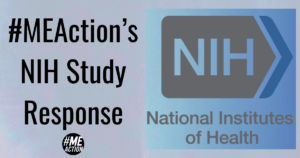Part II in our series on medical education and ME
Note: This is a two-part article in our series on education in ME/CFS. Part 1 covers UpToDate, the University of North Texas, Michigan State University, and the University of Nebraska; Part 2 will cover the University of California–San Francisco, the University of North Carolina, and other best sellers.
Medical school classrooms don’t expose students to information about ME or CFS, but could their assigned textbook readings expose them to it? After reviewing five high-ranking medical schools’ textbooks and Amazon.com’s best sellers, the answer is generally no: few textbooks give complete, accurate information about ME or CFS.
UpToDate is an online collection of information for students, patients, and physicians. Although thorough, some of UpToDate’s content is debatable. Searching UpToDate for “ME/CFS,” the search engine translates ME to be macular edema, not myalgic encephalomyelitis. One finds the following terms in the first 10 results: somatization, fibromyalgia, PTSD, lung cancer, and body dysmorphic disorder. Only two of the 10 are about ME or CFS as an entity, and both refer to the Institute-of-Medicine-suggested term systemic exertion intolerance disease (SEID).
The first relevant result is “Clinical Features and Diagnosis of Systemic Exertion Intolerance Disease (Chronic Fatigue Syndrome).” This page, last updated July 30, 2015, states patients are not faking symptoms. The second relevant result describes SEID treatments. It reports only counseling therapies and graded exercise therapy (GET) have a documented “meaningful benefit,” though “neither of these modalities is curative.” It has headings for antiretroviral, antibiotic, and work modification therapies, but reading this content requires a subscription.
UpToDate’s patient information page about SEID/CFS is vague in its description of how a diagnosis is made: “You must have unexplained, persistent, or relapsing fatigue, plus a number of the additional problems listed above.” The word or doesn’t exclude the many other fatiguing illnesses. On a positive note, the page explains that the illness can be completely incapacitating.

According to its required reading list, the College of Osteopathic Medicine at University of North Texas Health Science Center (UNTHSC) required second-year students in 2015-16 to subscribe to UpToDate, but it isn’t on the coming year’s booklist; and only two of the 34 textbooks required for 2016-17 first-year students mention CFS. First, Foundations of Osteopathic Medicine states CFS can cause myofascial pain and is a diagnosis of exclusion. Second, Bates’ Guide to Physical Examination and History Taking, the best-selling book in the Amazon category Nursing Diagnosis, solely mentions the rate of co-occurrence of CFS and fibromyalgia.
Michigan State University College of Human Medicine (MSUCHM) students subscribed to UpToDate in 2015-16, according to an interview with the school’s preclinical curriculum director. Not counting UpToDate or coursepacks, three out of MSUCHM’s 24 required medical textbooks for that year mention CFS. First, Medical Microbiology says CFS has characteristics of a viral infection. Second, Behavior and Medicine refers to CFS’s limited conventional treatment options. MSUCHM and MSU College of Osteopathic Medicine also required Bates’ Guide in 2015-16, and the bookstores of the medical schools at the University of California–San Francisco (UCSF) and University of Nebraska carry it.

The latter two bookstores also carry CURRENT Medical Diagnosis and Treatment 2016. It suggests tests to conduct to rule out other diagnoses, shows the CDC case definition, and brings up the need for more research on the effectiveness of rintatolimod (Ampligen) because of its documented exercise tolerance improvement and reduced need for other medications.
The treatment section, however, needs rewriting. It names medical management, cognitive behavioral therapy (CBT), and GET as treatments, claiming CBT’s effect is substantial and even curative for few patients. It continues, “A 2011 randomized trial (PACE trial) confirmed the benefits of cognitive-behavioral therapy and graded exercise; it found no benefit of adaptive pacing….All patients should be encouraged to engage in normal activities to the extent possible and should be reassured that full recovery is eventually possible in most cases” (p. 38, emphasis added).
Such reassurance would only be a lie. Only about five percent of patients fully recover, according to the CFS section in Harrison’s Principles of Internal Medicine, which is currently used at UCSF School of Medicine and is Amazon’s number five best-selling book in the clinical diseases category. This figure was quoted by Lapp at the CDC Public Health Grand Rounds this past year.
Though a second part to this textbook review is coming soon, it appears little has changed since Leonard Jason, Erin Paavola, Nicole Porter, and Morgan Morello examined the contents of 119 medical textbooks in 2010. They found CFS mentioned on 0.09 percent of the books’ pages, with treatment sections overemphasizing antidepressants, CBT, and GET.
#MEAction would like to thank Darla N. for her investigative reporting in this series! Read the stories in order by clicking on the links below:
1) Top Medical Schools Teach Little about ME/CFS
2) Medical Textbooks Earn a Failing Grade in ME/CFS – 1 of 2
3) Medical Textbooks Earn a Failing Grade in ME/CFS – 2 of 2
4) Three Schools of Alternative Medicine Teach about ME
Save
Save
Save
Save






8 thoughts on “Medical Textbooks Earn a Failing Grade in ME/CFS – 1 of 2”
In 2009-2011 I took a look at over 200 medical texts and related books that had or should have had sections on ME, such as internal medicine, and neurologic, immunologic, psychiatric illnesses textbooks. Unfortunately, few mentioned ME (or “cfs”), except for psychiatric texts, especially those on somatization. Almost all that mentioned ME had short, substantially inaccurate passages, many written by notorious charlatans like Stephen Straus and Simon Wessley, etc. Only 2 out of about 250 had substantially accurate passages on ME (or “cfs”). I posted reviews on most of these books. You can find them at amazon.com by searching for “Justin Reilly, JD”
this is a good effort but unfortunately we need to be contacting the writers themselves. i know a few people have begun letterwriting campaigns see here https://my.meaction.net/local_chapters/young-people-with-me/forum_threads/4719. likely there’s a more effective activism method but i’m at a loss to know what that is.
In my opinion, the way forward is to ensure that ME/CFS is included in the qualifying medical exams, and that the questions reflect the biomedical model rather than the biopsychosocial model. Teachers teach to the test in medical school. With so many topics, it’s natural that some get tossed to the site or ignored. Without ME on the exam, it will continue to be omitted from the textbooks created to help students pass those exams.
You’re right, Jaime. Great idea. Spoiler alert for another piece I’m writing: I found out that CFS (not sure about ME) is covered on the Naturopathic Physician Licensing Examination, so that gives an incentive for naturopathic schools to teach about ME/CFS. Allopathic and osteopathic medicine schools need to follow suit.
This is a very good break down of an important topic. Although we have a long way to go, this review documents a huge improvement to our benefit recently occurred over a short period of time. I do not think there were any text books that included ME or CFS except for Byron Hyde’s prior to P2P meeting. And secondly the quote toward the end of the article is a little misleading out of context especially in the discussion. I think a check of the original quote will find something to the effect that of people with sudden onset that remained severe after 5 years only about a 5 percent returned to their pre- illness level of functioning. However, I believe we still lack a good study that documents this. I was essentially told the same thing by my doc all the way back in 1993 (8 years into my illness). I had the sense it was undocumented observation of a small subgroup of patients seen by a small subset of doctors.
The 5% quotation was discussed at the CDC Grand Rounds, and appears to have been cited originally from: Rowe K. IAME/CFS Scientific Conference in Ottawa, Canada, September 2011.
Unfortunately, I think you’re right and that’s not from *published* research. We need more long-term epidemiological studies.
[Edit: ah ha! http://www.ncbi.nlm.nih.gov/pubmed/15699087 ]
Women’s Health Across the Lifespan: A Pharmacotherapeutic Approach by Laura Marie Borgelt (Ed) contains a section within the Neurology Chapter on ME/CFS and FMS.
That’s fantastic, Edna! Do you know what the tenor of the chapter is? What does it say about ME/CFS and FM?
Comments are closed.